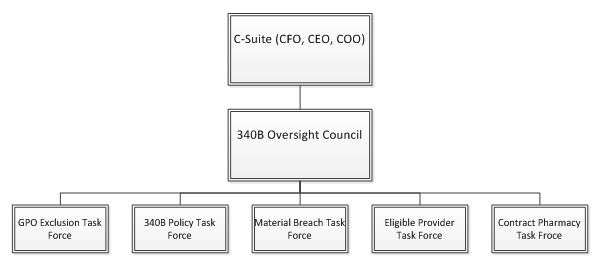Publication
Article
Pharmacy Practice in Focus: Health Systems
340B Oversight: Interdisciplinary Approach Ensures Continuous Compliance
The 340B drug pricing program was enacted in 1992.
The 340B Drug Pricing Program was enacted in 1992. Through this program, eligible health care providers, or covered entities, are able to purchase certain manufacturers’ covered outpatient drugs at discounted prices, with a program goal “to stretch scarce federal resources as far as possible, reaching more eligible patients and providing more comprehensive services.”1 There are several primary components of 340B compliance, including accuracy of covered entity registration/recertification, and the prohibitions on diversion, duplicate discounts, and use of a group purchasing organization (GPO) or arrangement for certain hospital covered entities.2 Each compliance component may be best understood by specific covered entity stakeholders. Implementation of a 340B Oversight Committee (340B OC) creates a mechanism for content experts and stakeholders within an organization to discuss important program administration topics. This concept has been identified as a best practice by Apexus, the designated prime vendor for the program and various 340B stakeholder groups.3,4
It is recommended that the 340B OC meet on a regular basis and involve a diverse group of covered entity stakeholders. An example list of 340B OC members is below. If unable to attend, an appropriate replacement attendee may be designated. It is important to note that different covered entities have varying levels of 340B dedicated and shared resources. Therefore, the composition of the 340B OC will vary based on organizational needs.
- Chief executive officer Chief financial officer Chief pharmacy officer or director of pharmacy
- Chief compliance officer
- Chief information technology officer and/or pharmacy informatics support
- Director of internal audit
- Director of finance
- Director of reimbursement
- Director of government relations
- Director of accounting
- Director of hospital supply chain
- Pharmacy procurement manager
- Manager(s) of pharmacy area(s) purchasing 340B-priced drugs
- 340B program manager or coordinator(s)
The 340B OC should be used to ensure the proper functioning and regulatory compliance of the covered entity. The committee may be charged with the following functions to accomplish this goal:
- Setting the general direction for 340B drug purchasing and compliance framework
- Establishing and maintaining policies and procedures
- Maintaining a plan for self-audits and external audits
- Reviewing reports, trends, and audit results
- Reviewing regulatory and legislative updates
- Providing compliance and oversight direction
- Establishing corrective action plans, when necessary
- Preparing for a Health Resources and Services Administration and/or manufacturer audit, when necessary
- Preparing responses for manufacturer good-faith evaluations, when necessary
- Determining self-disclosure appropriateness
Regular, scheduled meetings of the 340B OC may be supplemented by meetings of ad-hoc groups, including task forces or subcommittees. Task forces may focus on the operational impact of 340B regulations/policy changes or other areas, such as GPO exclusion compliance, material breach, contract pharmacy, etc. An example 340B OC organizational structure, with reporting relationships, is highlighted in the Figure.
Figure. An Example 340B OC Organizational Structure

Establishing a mechanism for stakeholders to provide perspective and expertise during administration of the covered entity’s 340B program, through implementation of a 340B OC, is an effective method in the program administration process that can be used to ensure continued compliance.
Grayson K. Peek, PharmD, MS, BCPS, is the manager of business development and integrity at the Duke University Hospital (DUH) Department of Pharmacy in Durham, North Carolina. He completed the 2-year health-system pharmacy administration residency at DUH in conjunction with a master of science in health-system pharmacy administration at the University of North Carolina at Chapel Hill. Dr. Peek is a PharmD graduate of the University of Tennessee Health Science Center. Alexandra M. Williams, BA, CPHT, is the 340B program manager at the University of North Carolina Hospitals in Chapel Hill, North Carolina. She completed her undergraduate degree in biology and health sciences at Guilford College. She is a certified pharmacy technician and has been involved in a 340B-related role for more than 4 years. She serves as a member of the Apexus Education Advisory Council.
References
- Health Resources and Services Administration. 340B Drug Pricing Program. hrsa.gov/opa/index.html. Updated May 2017. Accessed July 30, 2017.
- Health Resources and Services Administration. 340B Drug Pricing Program: program requirements. hrsa.gov/opa/programrequirements/index.html. Accessed July 30, 2017.
- Health Resources and Services Administration. 340B Peer-to-Peer Program: 340B Compliance Improvement Guide. hrsa.gov/opa/educationalresources/compliance-improvement-guide.pdf. October 1, 2015:14-17. Accessed August 15, 2017.
- Apexus. Sample 340B program policy and procedures manual: disproportionate share hospital (DSH). docs.340bpvp.com/documents/public/resourcecenter/DSH_PolicyManual.docx. 2016:21-22. Accessed July 30, 2017.







